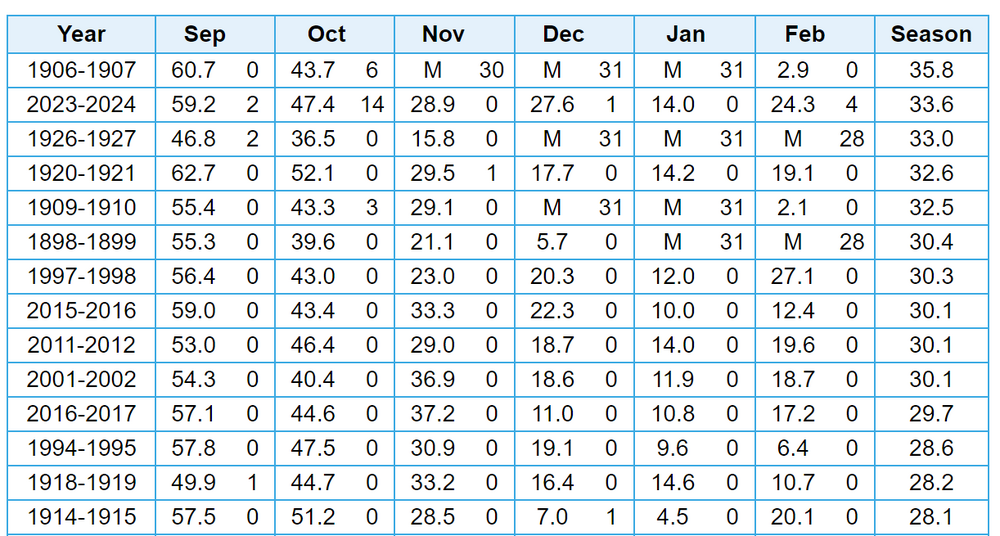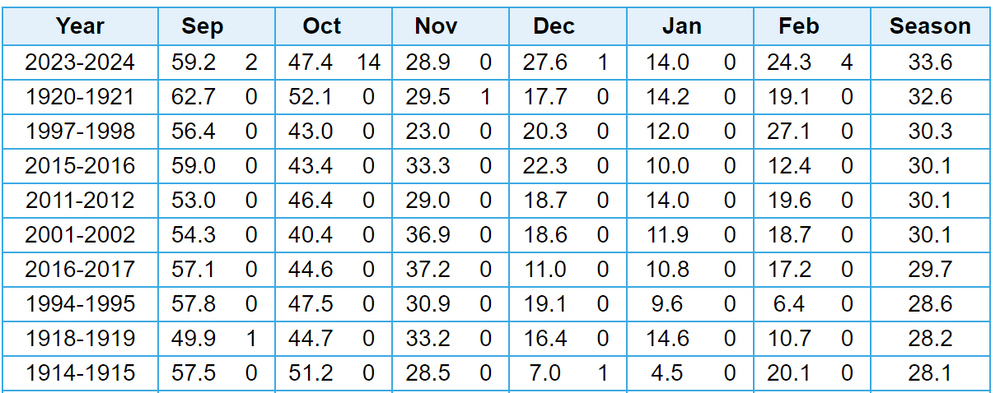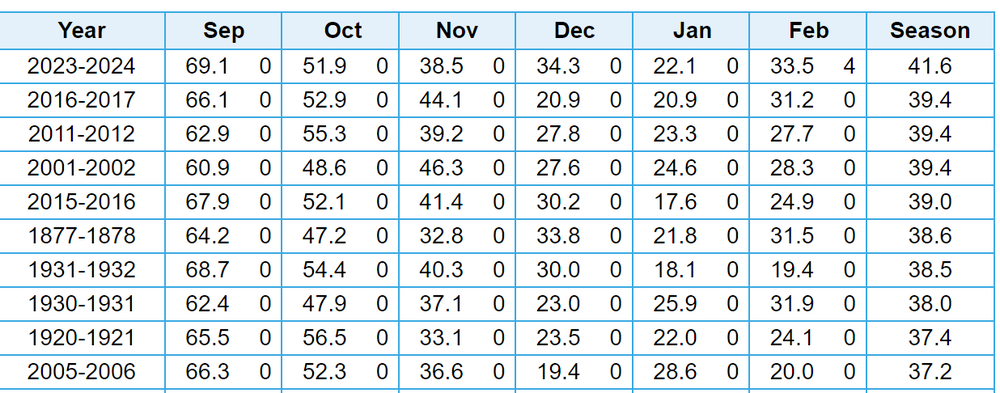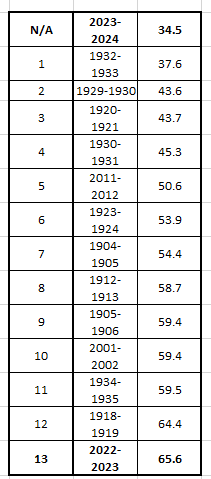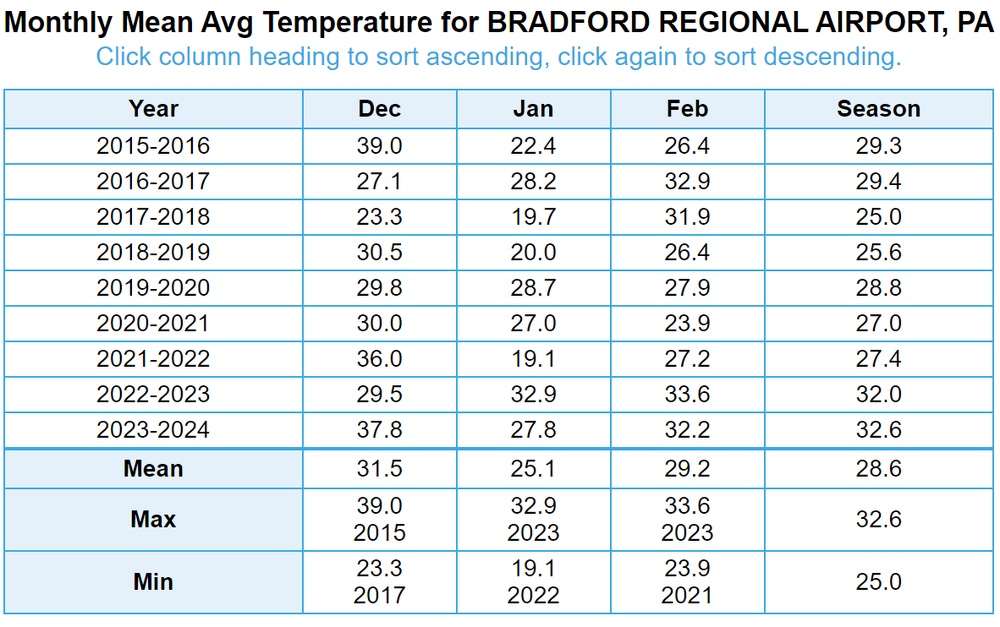
TheClimateChanger
Members-
Posts
4,048 -
Joined
-
Last visited
Content Type
Profiles
Blogs
Forums
American Weather
Media Demo
Store
Gallery
Everything posted by TheClimateChanger
-
The current temperature at both Flint and Saginaw is 69F, setting new monthly records and all-time winter seasonal high temperatures for both sites.
-
The current temperature at Lansing is 70F, setting a new monthly record high and tying the all-time winter seasonal record high temperature set on December 31, 1875. Records date to 1863.
-
The current temperature has reached 70F at Grand Rapids, Michigan, setting a new monthly and winter seasonal all-time record high.
-
Also, only the third time on record in which it reached 70F during meteorological winter. The all-time December high is 69F, and January 67F.
-
All-time monthly maximum, dating back to at least 1874.
-
The current temperature at Detroit is 70F. This ties the February monthly record maximum. Prior to this year, the only other dates on which it reached 70F are 2/24/2017 & 2/11/1999.
-
The current temperature of 71F at Toledo ties the February monthly record high temperature. Still plenty of time to exceed that value. It previously hit 71F on 2/24/2017, 2/26/2000, 2/11/1999, and 2/26/1944.
-
Minneapolis has now set two outright monthly record high temperatures in the last 5 months (with records dating to 1872) - 92 in October, and 65 in February. Additionally, only one year exceeded the 98F reading from September (1931 - 104, on 9/10; and 99, on 9/8), and the 55F reading in January has been exceeded only twice (1/25/1944 - 58F; and 1/24/1981 - 57F). Honorable mention to August - the 98F reading has only been exceeded in 9 years (5 of them by just one degree).
-
Actually ticked up to 65F later in the day.
-
Chicago Weather Records Tracking
TheClimateChanger replied to Chicago Storm's topic in Lakes/Ohio Valley
And before @michsnowfreak chimes in, I'm not saying those weren't mild winters. From the data I've seen they were all warm winters. That period had some weird ups and downs with some colder winters interspersed with very mild winters, but clearly with 5 of the top 6 [prior to this season] from that era, it's being affected by the location and exposure of the observing station. -
Chicago Weather Records Tracking
TheClimateChanger replied to Chicago Storm's topic in Lakes/Ohio Valley
The official station for Chicago has moved around a lot. At the time, it was downtown and near the lakeshore, with a rooftop exposure. You can see the locations here from the 1947 annual climate data publication. You can see the thermometers were situated 70-75 feet above ground in the 1870s and 1880s, and then from 140 to 240 feet above ground until the move to the university. Looks like they were properly sited 7 feet about the ground there. Probably exaggerates the urban heat island effect since rooftop measurements tend to run warmer than ground temperatures. The downtown station at the Courthouse anyways did tend to run about 2-2.5F warmer than Midway Airport during the winter, and a degree or so warmer than the University of Chicago site. The yearly means at Midway and University of Chicago were similar, with downtown about 1-1.5F warmer. -
Occasional Thoughts on Climate Change
TheClimateChanger replied to donsutherland1's topic in Climate Change
-
INL set a monthly record high last month, but will come short of the February record high. Still one of only a handful of years in which it reached 50F or better in February.
-
MSP up to 63F. All-time monthly high of 64F from 1896 in jeopardy. All-time seasonal high of 68F from December 1998 appears to be safe.
-
Pittsburgh, Pa Winter 2023-24 Thread.
TheClimateChanger replied to meatwad's topic in Upstate New York/Pennsylvania
Made it all the way up to 68. Beautiful spring day. -
Pittsburgh, Pa Winter 2023-24 Thread.
TheClimateChanger replied to meatwad's topic in Upstate New York/Pennsylvania
Up to 64 on my weather station. -
-
At International Falls, limiting the analysis only to years with data for all months (of course), 2023-2024 is 1F warmer than 1920-1921 & 3.3F warmer than 1997-1998. Most of the early years in this list are missing multiple cold season months - i.e., the 33.0F in 1926-1927 is the mean of the fall only and is 0.6F colder than the mean of fall and winter this year.
-
Prolific, long-lasting warmth. The mean of the preceding 6 months at MSP is 2.2F warmer than any prior year of record over the same period.
-
Pittsburgh, Pa Winter 2023-24 Thread.
TheClimateChanger replied to meatwad's topic in Upstate New York/Pennsylvania
All in all, we've done incredibly well with snowfall this winter with only 6.5" less than Erie to date, per the official observations. -
Pittsburgh, Pa Winter 2023-24 Thread.
TheClimateChanger replied to meatwad's topic in Upstate New York/Pennsylvania
Sorry, had to include March 1 since it doesn't accept February 29th as an end date. Good chance for 3 more in 2024. Certainly a long-term uptrend, but not a huge change since the 1990s. Bigger upswing since 2015, however. -
Yes, pretty bad. I looked into this yesterday. As @BuffaloWeather pointed out, the pre-1949 numbers aren't really directly comparable to the modern values since the city station is less favored for LES than the airport and averaged significantly lighter snowfall. Note that xMacis is missing a lot of data, so I had to dig into the old Monthly Weather Review to find the complete seasonal totals for some of the earlier years at the city office. Last year was the third least since the winter of 1934-1935 [only 2011-2012 & 2001-2002 saw less snowfall], but this winter has seen barely half of last year's total thus far. Another 16.1" could fall, and it would still be the least ever observed at KSYR and top 5 least in the threaded record. And the advent of snowboards and periodic 6-hourly measurements certainly inflates some of the recent tallies compared to many decades ago, especially with fluffy, airy lake effect snow.
-
Also BTV. Most recent 9 year period [March - February calendar] is averaging 48.8F versus a 45.9F average from 1981-2010. So that's about 3 degrees for the entire year, not just winter. March 1980 - February 2010 Average Note: The warmest 12-month period from 3/80 - 2/10 is 0.7F below the mean of the last nine years.
-
That's child's play. How about +5.1F over a 9-year period? The coldest February is the same average as the 1981-2010 mean for the month, and the coldest winter season 1.5F above the 1981-2010 mean. 1981-2010 Averages
-
Winter '23-'24 Piss and Moan/Banter Thread
TheClimateChanger replied to IWXwx's topic in Lakes/Ohio Valley
Yeah, no doubt site location changes can make a huge difference. I've pointed this out here, but received pushback from some of the southeast Michigan crew. I don't think they realize how snowfall totals can easily vary by a foot or two in the snowbelts in a matter of miles or over a couple hundred feet of elevation. I just included all of the corrected data [as noted, xMacis is missing a lot of the snowfall pre-1940] to provide a useful comparison. Even neglecting the bias introduced by location and procedural changes, last winter was 13th least in the threaded record and this winter is well on track to place in the top 5. Still over 3" under the current least snowy winter (1931-1932). In fact, post-1935, only the winters of 2001-2002 & 2011-2012 had less snowfall in Syracuse than last winter.




